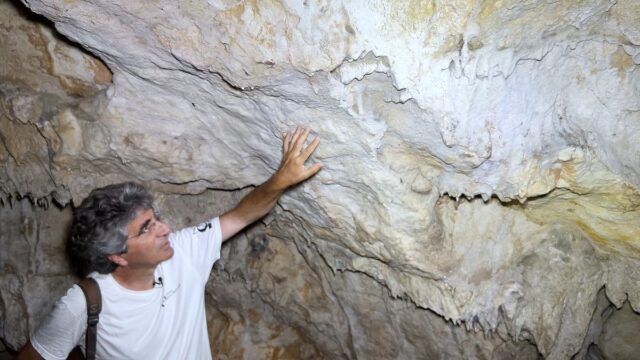As Sicily faces one of the worst droughts in recent decades, the University of Catania organizes a series of events as part of the EU Green Week 2024. Scientists take us on a journey back in time to better understand the impact of climate change on the island.
“Almost all the water that Sicilians consume comes from underground,” explains Professor Sandro Privitera, a geologist at the University of Catania, as we enter one of the many karst caves on the Catania plain.
In these cavities formed in the limestone several million years ago, the cool humidity contrasts with the scorching heat of the surface. Drops of water fall from the stalactites. But this phenomenon is being altered by climate change.
“Normally, you hear the sound of drops falling, but the water flows much less than before. Some of the limestone rocks are fossilizing due to the lack of rain,” explains the archaeologist, pointing to a whitewashed wall.
When we left the furnace of the Grotta Palombara Nature Reserve – one of the seven reserves managed by the University of Catania – the professor’s team had cut the tall grass to limit the risk of fire. They have also planted more drought-resistant trees. Some bloomed already in January of this year.
The vegetation in this area is steppe. Plants are becoming rarer. “When the Greeks arrived here, everything was covered in trees. Since then they have been cut down and burned to make way for pastures and farmland,” explains Professor Privitera.
“Little by little, we are trying to recover biodiversity. Planting trees increases the soil’s capacity to retain water, so it remains moist and gives the vegetation more possibilities to develop,” explains the scientist.
Further down, a stream witnesses the magic of karst systems: although there has been almost no rain in the region this year, the water slides through a valley populated with trees, flowers and insects.
“Water is gold. It is an opportunity and a paradise. We can live without oil or cars, but not without water. We must preserve it at all costs,” explains Professor Privitera.
The University of Catania, with the mission of increasing water resistance
The University of Catania has organized a series of events entitled “The future in drops, the role of protected areas in water resilience” as part of the EU Green Week. The University organizes guided tours of nature reserves to highlight the role of protected areas in mitigating climate change.
In the museum in Piazza della Università, scientists also share their views on climate change in Sicily. The skeleton of an elephant is on display, an animal that once inhabited the wetlands of the Catania plain. The pachyderm, witness to the evolution of the region’s fauna through time, is now the symbol of the city and its University.
Great changes have occurred over the millennia, both on land and underwater. “Marine ecosystems have always been resilient and have always adapted to environmental variations,” explains Professor Rossana Sanfilippo, Director of the Oceanology and Paleoecology Section of the Department of Geological Sciences at the University of Catania, while showing us mollusks that today They live in the boreal oceans but whose fossils are abundant in Sicilian waters.
On the contrary, the Sicilian seas are full of new species from other parts of the world. This is the case of a small mussel that arrived from the Indian Ocean through the Suez Canal. “They are finding a favorable climate because the sea temperature is rising. But these invasive species now threaten the local fauna,” explains researcher Emanuela Di Martino.
Professor Barone recalled that during the Quaternary, about 2.5 million years ago, in this region of the world glacial periods and interglacial periods alternated, with high temperatures.
“But today the problem is more complex, because climate change is compounded by the impact of human activity. Greenhouse gas emissions are causing sea level rise, abnormal temperature rises and sea acidification. This represents a huge problem for many living organisms, such as corals,” concludes the professor.







